How Many Pickleball Courts Fit on a Tennis Court?
Pickleball, a sport that combines aspects of tennis, badminton, and ping-pong, has been growing rapidly in popularity across the United States. As more enthusiasts look for places to play, a common question arises: How many pickleball courts fit on a tennis court? Understanding the spatial requirements and conversion techniques is crucial for optimizing facilities and accommodating the increasing number of players. This article delves into the dimensions, conversion processes, safety measures, and the broader benefits of multi-purpose sports facilities, providing a comprehensive guide to anyone looking to make the most of their existing tennis courts.
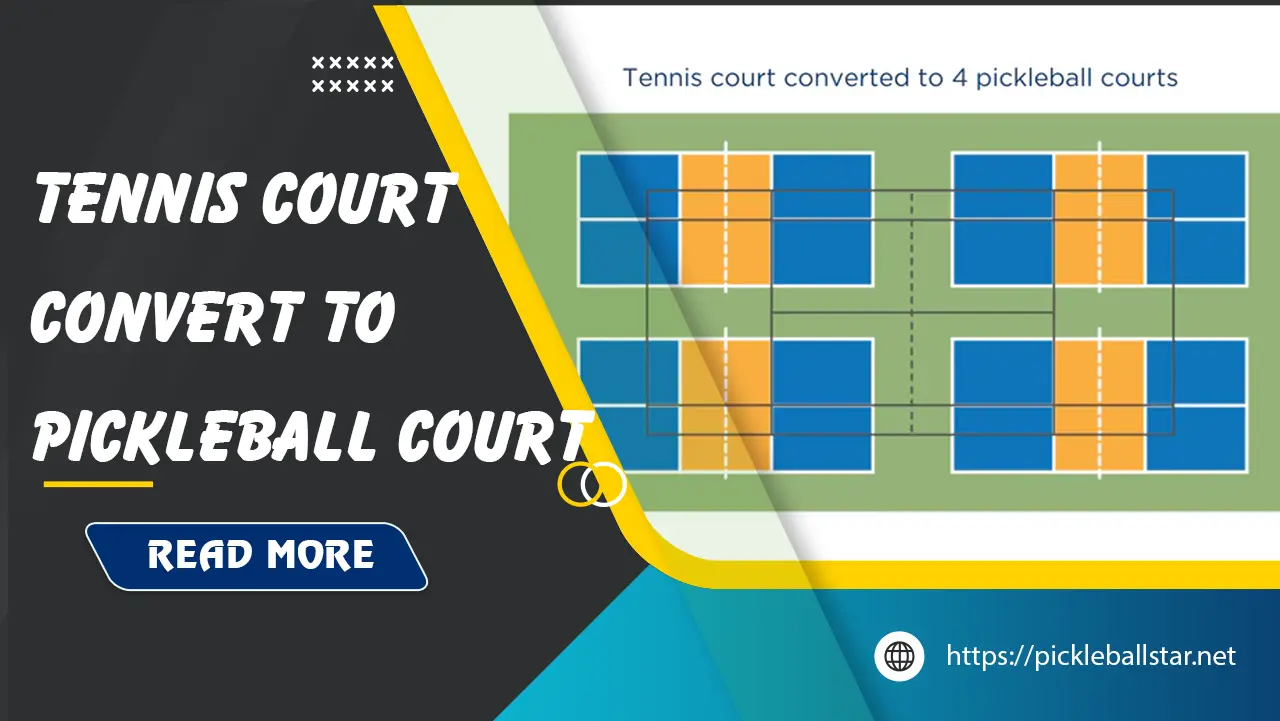
How many pickleball courts fit on a tennis court
Pickleball court dimensions
Pickleball courts are significantly smaller than tennis courts. According to official regulations, a standard pickleball court measures 20 feet wide and 44 feet long. This compact size not only makes the game more accessible for players of all ages but also allows for multiple courts to be set up within the bounds of a single tennis court. Understanding pickleball court dimensions is the first step in planning for effective court conversions.
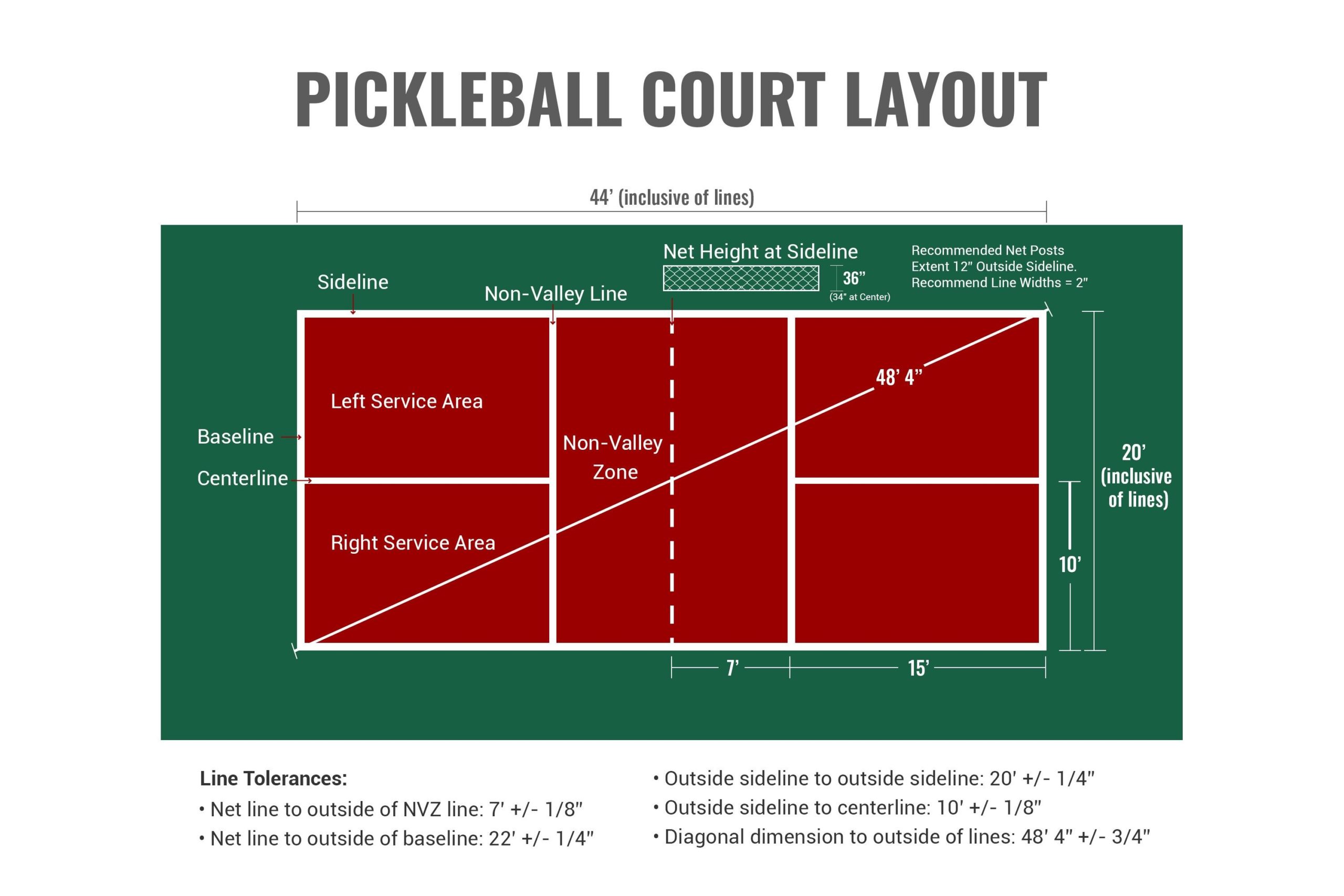
The pickleball court is divided into specific areas: the non-volley zone (also known as the “kitchen”), service courts, and baselines. The net stands at 36 inches high at the sidelines and 34 inches at the center. Establishing these zones clearly is essential for ensuring that the game is played according to official rules and standards.
The importance of precise measurements cannot be overstated. A well-marked court sets the stage for fair play and reduces the risk of accidents. While the smaller dimensions of a pickleball court might seem limiting, they actually create a more dynamic and fast-paced game, which is part of the sport’s appeal.
Tennis court dimensions
In contrast, a standard tennis court is much larger, measuring 60 feet in width and 120 feet in length. This expansive space allows for singles and doubles matches, each with their own specific boundary lines. The tennis net stands at 42 inches at the sides and 36 inches at the center, towering over the lower pickleball net. These larger dimensions provide ample room for tennis players to maneuver and execute powerful shots.
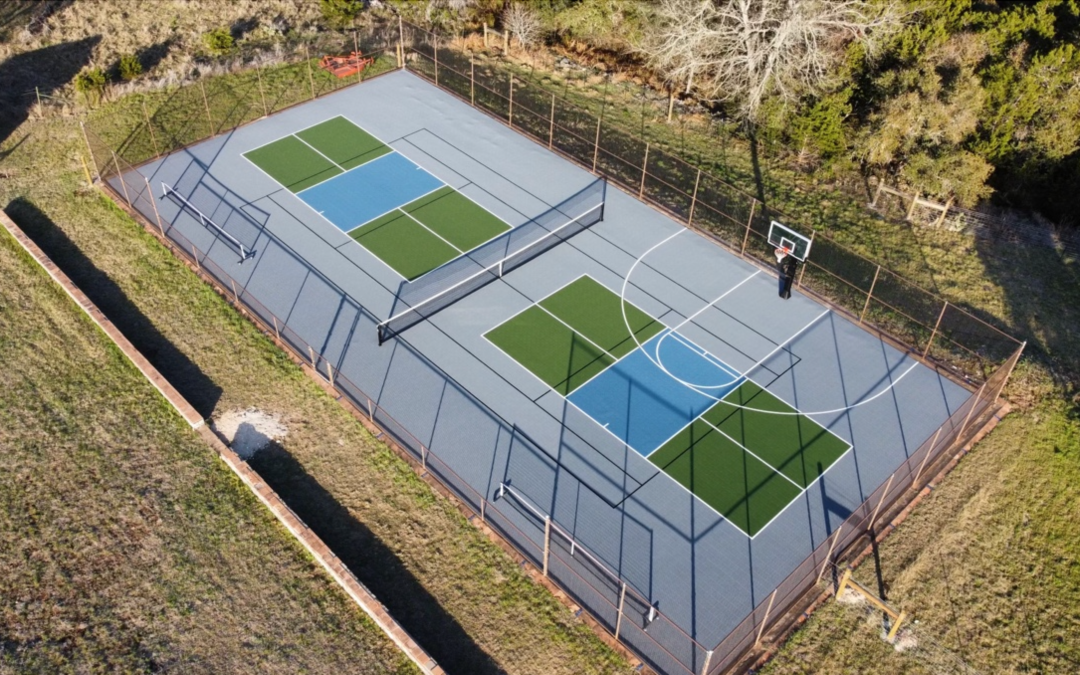
However, the generous size of a tennis court also means there’s plenty of space to accommodate multiple pickleball courts. By taking advantage of this, facilities can maximize their utility and provide more playing opportunities for the growing number of pickleball enthusiasts.
The size difference between the two courts is a key factor in conversion processes. When planning to overlay pickleball courts on a tennis court, it’s essential to consider the spacing between courts, the orientation of nets, and potential boundary adjustments to ensure everything fits comfortably and safely.
Conversion process and court layout
Court orientation
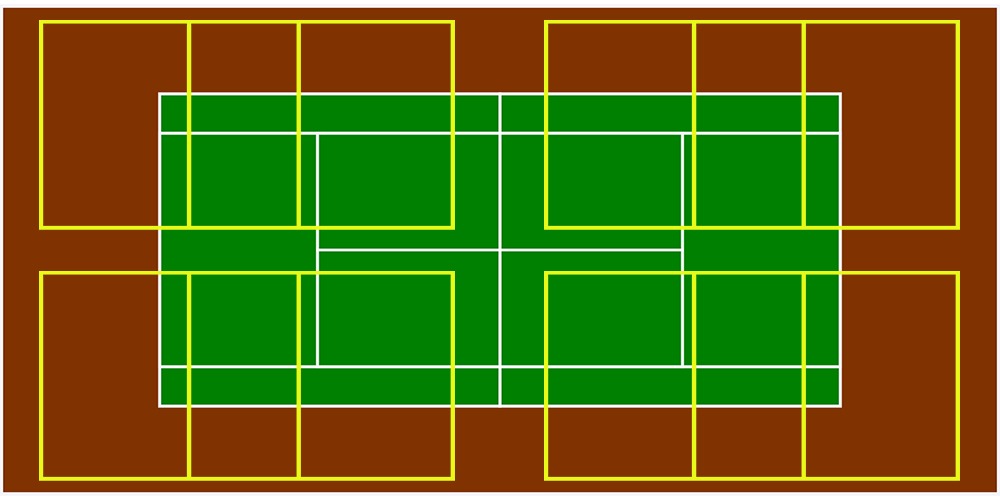
When converting a tennis court into multiple pickleball courts, the orientation of the courts is crucial. There are several ways to arrange pickleball courts on a tennis court, each with its own advantages.
- Single pickleball court: When space is not a constraint, a single pickleball court can be laid out in the center of a tennis court for plenty of room around the playing area. This allows for a comfortable and safe playing environment.
- Two parallel courts: For setups requiring more play options, two pickleball courts can be placed parallel to each other, sharing the tennis net or using separate nets. This is particularly useful for small groups or practice sessions.
- Four courts configuration: The most efficient use of a tennis court space would be to fit four pickleball courts, arranged either vertically or horizontally. This layout maximizes the use of the entire tennis court surface and allows for multiple games simultaneously.
By carefully planning the orientation and precise placement of each court, facilities can ensure optimal use of space while maintaining safety and comfort for players.
Additional nets and placement
One of the significant aspects of converting a tennis court into multiple pickleball courts is handling the nets. While tennis nets are higher than pickleball nets, clever adjustments can make the process simple and effective.
- Adjusting the tennis net height: Tennis nets can be lowered to meet the height requirements for pickleball. Using the middle strap, the net can be lowered to 34 inches at the center and adjusted at the sides.
- Installing dedicated nets: For a more permanent solution, dedicated pickleball nets can be installed. These can be portable or permanent, based on the facility’s preference. Portable nets offer flexibility, allowing the court to be converted back to tennis easily, whereas permanent nets provide a more stable and official setup.
Boundary adjustments
Establishing clear boundary lines is essential for fair play and safety. Adding or modifying boundary lines can be done in various ways, depending on whether the conversion is temporary or permanent.
- Temporary markings: Court tape, chalk, or other temporary materials can be used for short-term adjustments. These are easy to apply and remove, making them perfect for facilities that switch between sports frequently.
- Permanent markings: For facilities looking to make a long-term commitment to pickleball, painting permanent lines is a more durable solution. Specialized paint that withstands wear and weather should be used to ensure the markings remain visible and intact over time.
Ensuring that the boundaries are clearly marked helps in maintaining the integrity of the game and prevents disputes during play. Whether temporary or permanent, precise boundary lines are a key part of a successful court conversion.
Considering court usage and etiquette
Revolve court usage
One of the primary considerations when managing court space is how to effectively rotate and share usage. This is particularly important in facilities where both tennis and pickleball need to coexist. Clear scheduling helps reduce conflicts and ensures that players of both sports get fair access to the courts.
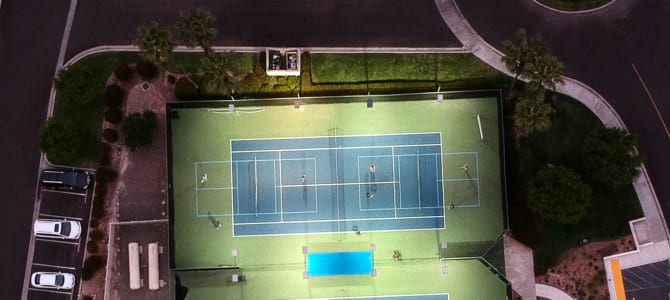
Facilities can use reservation systems, sign-up sheets, or digital scheduling apps to manage court usage. Setting designated times for each sport can also help, ensuring that players know in advance when they can expect to play. This structure helps to maximize court utility and keeps players satisfied.
Additionally, having dedicated staff to oversee the smooth transition from one sport to another can enhance the user experience. Keeping communication channels open with players and regularly updating them about court availability can prevent misunderstandings and ensure everyone gets a fair chance to play.
Understand and adapt to different skill levels
Player skills can vary widely, from beginners to advanced competitors. Catering to these different levels requires thoughtful court management. For example, setting up courts specifically for beginners can encourage new players to join without feeling intimidated by more experienced opponents.
Skill-level-specific scheduling can help. Beginners can have designated time slots, while more advanced players can have separate times. This segmentation not only makes the playing experience smoother but also allows each group to focus on improving at their own pace.
Hosting workshops, clinics, and open play sessions tailored to various skill levels fosters an inclusive environment. Encouraging players to participate in mixed-skill games occasionally also promotes a more cohesive community and helps everyone improve their game.
Maintain appropriate noise levels
Pickleball, while fun and engaging, can generate substantial noise, especially when several games are happening simultaneously. This can become a concern in residential areas or shared sports facilities. Strategies to mitigate noise include using noise-absorbing materials, like specialized fencing or windbreaks.
In addition, choosing quieter balls and paddles designed to minimize noise can make a significant difference. Playing during off-peak hours or limiting playtime during early mornings and late evenings also helps in reducing noise disturbances.
Addressing noise concerns proactively shows consideration for surrounding residents and other facility users, fostering a more harmonious relationship and ensuring that pickleball play continues without complaints.
Safety and precautionary measures
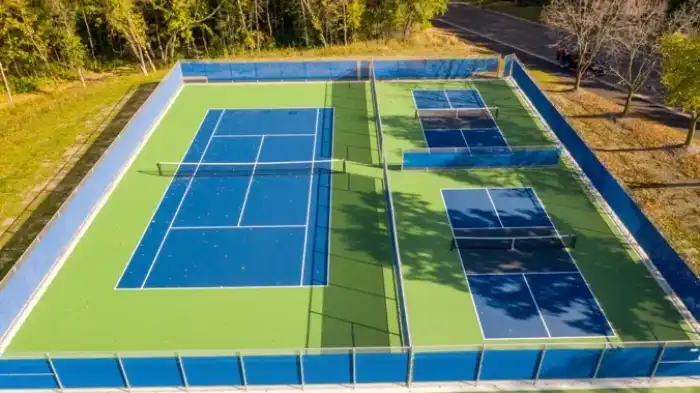
Keep adequate space between courts
Safety is paramount in any sports facility. When placing multiple pickleball courts on a tennis court, it’s essential to maintain adequate space between each court to prevent collisions and provide a safe environment for all players.
- Out-of-bounds space: Ensure there is at least 4 feet of clearance around each pickleball court. This space is crucial for players to move freely without risking injury.
- Spectator space: For facilities hosting events or regular play sessions, allocate areas for spectators and benches, keeping them safely away from the playing area.
These safety considerations help in creating a safe and enjoyable environment for everyone, whether they are playing or watching.
Monitor court conditions
Regular maintenance and monitoring of court conditions are essential for player safety and the longevity of the court surface.
- Surface checks: Regularly inspect the court for cracks, uneven areas, or debris. Addressing these issues promptly keeps the court safe and playable.
- Net inspections: Ensure the nets are in good condition and properly adjusted for pickleball play. Replace damaged nets as necessary.
- Weather considerations: Be mindful of weather conditions. Wet or excessively hot conditions can affect the court surface and player safety. Plan maintenance activities accordingly to keep the court in optimal condition.
Proactive maintenance minimizes risks and enhances the overall player experience, ensuring the court remains in good condition for all users.
Establish clear rules and expectations
Clear rules and expectations help in managing court usage effectively and maintaining a respectful playing environment.
- Court rules: Post rules clearly at the court entrance. This should include guidelines on court usage, scheduling, and etiquette.
- Safety protocols: Educate players on safety protocols, including proper footgear, hydration, and warming up before play.
- Conflict resolution: Establish a clear process for resolving disputes or conflicts that may arise during play, ensuring that all players feel heard and respected.
By establishing and enforcing rules and expectations, facilities can maintain order and create a positive environment for all players.
Permanent conversion and court maintenance

Painting permanent lines
For facilities making a long-term commitment to pickleball, painting permanent lines is an effective solution. Permanent lines provide clear, durable boundaries that withstand regular play and weather conditions.
- High-quality paint: Use specialized court paint designed for durability and visibility. This ensures the lines remain clear and do not fade quickly.
- Professional application: Considering hiring professional court painters to ensure the lines are straight, accurate, and meet regulatory standards.
- Dual lines: If the court will serve multiple purposes, consider using different colors for pickleball and tennis lines to avoid confusion.
Permanent lines enhance the playing experience by providing clear, lasting boundaries, reducing the need for frequent re-marking.
Regular court maintenance
Regular maintenance goes hand-in-hand with permanent conversions to ensure the court remains safe and enjoyable for all players.
- Surface cleaning: Regularly sweep or pressure-wash the court to remove debris and prevent build-up that could cause slipping.
- Line touch-ups: Periodically check and touch up the lines to keep them visible and in good condition.
- Net adjustments: Regularly inspect and adjust the nets to ensure they remain at the correct height for pickleball.
Consistent maintenance prolongs the life of the court and ensures a high-quality playing surface for all users.
Benefits of multi-purpose courts
Greater access to playing spaces
Multi-purpose courts significantly increase the accessibility of playing spaces, allowing more people to enjoy a variety of sports. This flexibility is particularly valuable in communities with limited space or resources.
- Shared use: By accommodating multiple sports, facilities can serve more users without the need for additional infrastructure.
- Increased participation: Providing options for various sports encourages more community members to participate in physical activities, promoting overall wellness.
This increased access contributes to a healthier, more active community, maximizing the utility of existing spaces.
Versatility for sports facilities
The versatility of multi-purpose courts offers substantial benefits for sports facilities, enabling them to cater to diverse interests and maximize usage.
- Scheduling flexibility: Facilities can offer different sports at different times, ensuring continuous use of the courts and optimizing revenue.
- Broad appeal: Multi-purpose courts attract a wider range of users, from tennis players to pickleball enthusiasts, increasing overall participation and engagement.
This versatility makes sports facilities more appealing and valuable to the community, enhancing their role as vital recreational hubs.
Fostering community growth
Multi-purpose courts serve as community hubs, bringing people together and fostering a sense of unity and engagement.
- Social interaction: Sports provide opportunities for socializing and building relationships, enhancing the sense of community.
- Events and tournaments: Hosting events and tournaments for various sports can attract participants and spectators, strengthening community bonds and boosting local engagement.
By fostering community growth, multi-purpose courts contribute to a more connected and vibrant community, promoting inclusivity and togetherness.
Frequently asked questions
Can you play pickleball on a tennis court?
Yes, playing pickleball on a tennis court is entirely possible and quite common. Tennis courts can accommodate multiple pickleball setups, allowing players to enjoy the sport without additional infrastructure.
- Temporary setup: Use tape, chalk, or court markers to outline pickleball court boundaries. Adjust the tennis net to the appropriate pickleball height.
- Permanent conversion: For long-term use, consider painting permanent lines and installing dedicated pickleball nets.
These options provide flexibility and accessibility, making tennis courts valuable assets for pickleball play.
Can you play pickleball in the rain?
Playing pickleball in the rain is possible but requires extra caution to ensure safety.
- Wet conditions: Rain can make the court surface slippery and affect ball bounce. Players should wear appropriate footwear with good traction and avoid playing on courts with standing water.
- Indoor options: Consider playing in indoor facilities if available, to avoid weather-related issues and ensure a safer playing environment.
Exercise caution and prioritize safety when playing in wet conditions to prevent injuries and accidents.
Can you play pickleball on grass?
While pickleball is best played on hard, smooth surfaces, it can also be played on grass for casual, recreational play.
- Adjustments: Use a rubber ball instead of a standard plastic pickleball, as it bounces better on grass. Clear the playing area of debris and maintain the grass short for better playability.
- Limitations: Grass surfaces are not ideal for competitive play due to inconsistent bounces and footing, but they are suitable for informal games and practice sessions.
Grass courts offer a flexible, alternative playing surface for casual pickleball enthusiasts.
Conclusion
The conversion of tennis courts to pickleball courts is a practical and efficient way to meet the growing demand for pickleball facilities. By understanding the dimensions, orientation, and specific requirements of both sports, communities can maximize their resources and provide versatile playing spaces. Proper planning, safety measures, and regular maintenance ensure that these multi-purpose courts remain safe and enjoyable for all users. Embracing the benefits of multi-purpose sports facilities not only enhances access to various sports but also fosters community growth and engagement, creating vibrant, active, and connected environments. Whether through temporary setups or permanent conversions, the ability to accommodate multiple pickleball courts on a tennis court is a testament to the adaptability and potential of shared recreational spaces.
